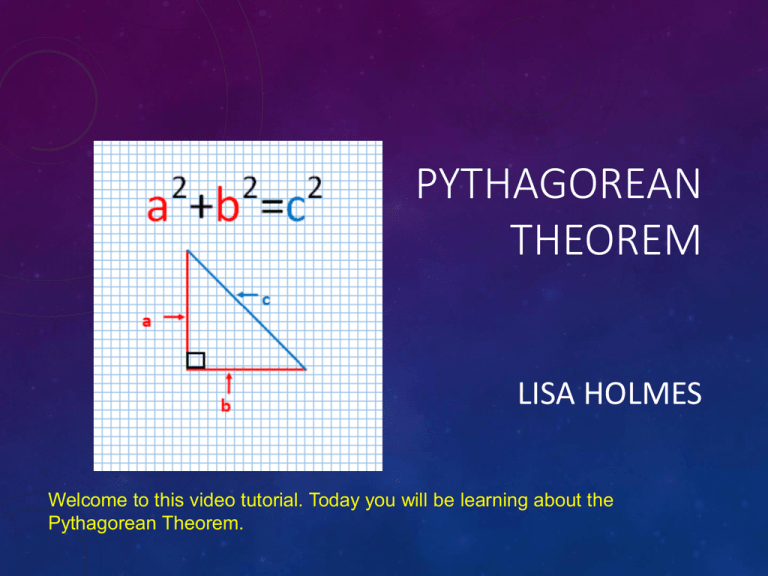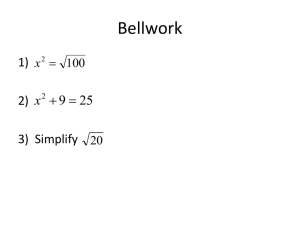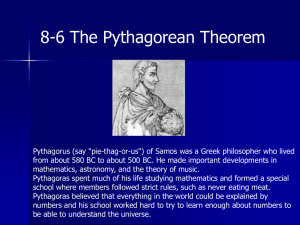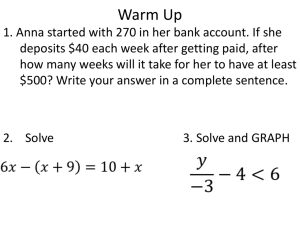Storyboard - TeacherWeb
advertisement

PYTHAGOREAN THEOREM LISA HOLMES Welcome to this video tutorial. Today you will be learning about the Pythagorean Theorem. REAL WORLD USES OF THE PYTHAGOREAN THEOREM • Determining what size ladder to use when painting a wall • Finding the shortest distance when traveling • Deciding what size television you need or want to buy • Deciding what size computer monitor you would like to buy • Determining arrow trajectory in archery in order to hit the target • Designing a new staircase Narrator will ask the questions: “How can understanding the Pythagorean Theorem help you in your everyday life?” “What can you use it for?” “Here are just a few examples.” Narrator will then read the list of uses of the Pythagorean Theorem as the bullet points appear on the screen. LEARNING OBJECTIVES • By the end of the training video, given information on the Pythagorean Theorem, trainees will be able to: • Name and identify the parts of a right triangle • Identify the algebraic equation of the Pythagorean Theorem • By the end of the training video, given a demonstration and guided practice, trainees will be able to: • Solve a problem using the algebraic model of the Pythagorean Theorem Narrator: “What exactly will you learn from watching this video?” “Here are the learning objectives:” Narrator will then read the objectives as they appear on the screen. REQUIRED SKILLS • Before watching this video tutorial you should already have a good understanding of: • Right angles • Basic algebra including • Solving algebraic equations • Order of operations • How to simplify squares • How to solve for square roots Narrator: “Before moving forward with this tutorial, it is important to point out the skills you should already have in order to successfully meet the learning objectives of this video.” Narrator will read the prerequisite skills. “If you do not have these skills, you may want to stop this video and review other videos that teach these skills before moving forward.” LEARNING OBJECTIVE 1 • By the end of the training video, given information on the Pythagorean Theorem, trainees will be able to: • Name and identify the parts of a right triangle Narrator: “The first part of this tutorial will help you to name and identify the parts of a right triangle.” RIGHT TRIANGLE Definition of a Right Triangle • Right Triangle – a triangle that has a right angle (90o) Narrator: “The graphic shown here provides an example of what a right triangle looks like. A right triangle is a triangle where one of the three angles is 90 degrees. A 90 degree angle is called a right angle.” PARTS OF A RIGHT TRIANGLE Definitions • Leg(s) – the sides that form the right angle (shown here in red) • Hypotenuse – the side opposite the right angle in a right triangle (shown here in blue) Narrator: “Besides the right angle, a right triangle has three main parts that you need to become familiar with; two legs and one hypotenuse.” Narrator will then read the definitions and point out the color coordination within the graphic. SELF-CHECK QUESTION Question: Is the red arrow pointing to a leg or the hypotenuse? Narrator: “It’s time to check your understanding. Is the red arrow in the graphic pointing to one of the legs or at the hypotenuse? Pause the video and when you think you have the answer, press play to see if you are correct.” SELF-CHECK ANSWER Answer: LEG Narrator: “The correct answer is LEG. If you got the right answer, Congratulations! If you did not, feel free to rewind the video to review and then try again.” SELF-CHECK QUESTION Question: Is the red arrow pointing to a leg or the hypotenuse? Narrator: “Let’s try another one. Is the red arrow on the graphic pointing to one of the legs or at the hypotenuse? Pause the video until you think you have the right answer and then press play to see if you are correct.” SELF-CHECK ANSWER Answer: HYPOTENUSE Narrator: “The correct answer is HYPOTENUSE. If you got the right answer, Congratulations! If you did not, again, feel free to rewind the video to review and then try again before moving forward.” LEARNING OBJECTIVE 2 • By the end of the training video, given information on the Pythagorean Theorem, trainees will be able to: • Identify the algebraic equation of the Pythagorean Theorem Narrator: “Now that you can name and identify the parts of a right triangle, it is time to learn how to identify the algebraic equation of the Pythagorean Theorem.” ALGEBRAIC EQUATION FOR THE PYTHAGOREAN THEOREM Narrator: “The graphic shown displays the algebraic equation of the Pythagorean Theorem a2+b2=c2. Notice the color coding between the equation and the right triangle? Keep watching and you will soon understand.” ALGEBRAIC EQUATION EXPLAINED a2 + b 2 = c 2 • a= the length of one leg • b= the length of the other leg • a and b are interchangeable; it does not matter which leg is labeled a and which leg is labeled b • c= the length of the hypotenuse Narrator: “When solving the Pythagorean Theorem you are ultimately looking for the length of one of the sides of a right triangle when you know the length of the other two sides. The letters in the equation (a,b and c) are specific to the sides of the right triangle. The letter a is specific to a leg, the letter b is specific to the other leg and the letter c is specific to the hypotenuse. It is important to know that it does not matter which leg you apply the letters a and b to; they are interchangeable. But, the letter c is ALWAYS applied to the hypotenuse.” SELF-CHECK QUESTION • Label the legs of the right triangle using a, b and/or c • NOTE: There are two possible correct answers Narrator: “Lets check your understanding of the algebraic equation. Pause the video while you attempt to label the legs of the right triangle shown in the graphic here using the letters of the algebraic equation (a, b and/or c). Play the video to check your answer. Need a helpful hint? There are two possible ways to label the legs of the right triangle.” SELF-CHECK ANSWER Correct Answers REMINDER: a and b are interchangeable; it does not matter which leg is labeled a and which leg is labeled b Narrator: “The correct answers are a and b or b and a. Did you get it right? Congratulations if you did! If you need a refresher, feel free to rewind the video for a quick review.” SELF-CHECK QUESTION • Label the hypotenuse of the right triangle using a, b, and/or c Narrator: “Let’s try another one. Pause the video while you attempt to label the hypotenuse using the letters of the algebraic equation (a, b and/or c). Press play when you are ready to check your answer.” SELF-CHECK ANSWER Correct Answer The hypotenuse is always labeled “c” Narrator: “The answer is c. Remember, the letter c is always specific to the hypotenuse. Now, let’s review before we move on with solving problems.” ALGEBRAIC EQUATION REVIEW • The algebraic equation used to solve the Pythagorean Theorem is a2+b2=c2 • “a” represents the length of one leg of the right triangle • “b” represents the length of the other leg of the right triangle • “c” represents the length of the hypotenuse of the right triangle • Thus, the formula can be understood to mean that the length of one leg squared plus the length of the second leg squared equals the length of the hypotenuse squared. Narrator: “Here are a few important things to remember regarding the algebraic equation of the Pythagorean Theorem.” Narrator will then read the bullet points as they appear on the screen. LEARNING OBJECTIVE 3 • By the end of the training video, given a demonstration and guided practice, trainees will be able to: • Solve a problem using the algebraic model of the Pythagorean Theorem Narrator: “Now that you can name and identify the parts of a right triangle and you can identify the algebraic equation of the Pythagorean Theorem, it is time to solve a problem using the algebraic model of the Pythagorean Theorem.” ALGEBRAIC MODEL DEMONSTRATION Steps: • • • Solve for the hypotenuse: Begin with the equation Plug in the values for a, b, and c based on the graphic shown (a=3, b=4, c=?) • • • 𝑐2 = 25 Solve the equation • The narrator will verbally walk the trainee thru the steps provided as they appear on the screen, pausing at each step. 25=c2 Simplify the equation by finding the square root of both sides of the equal sign • • 9+16=c2 Add the values • • (3) 2=9 and (4) 2=16 By simplifying, the equation becomes: • • (3) 2+(4) 2=c2 Solve the squares to simplify: • • a2+b2=c2 c=5 Answer: The length of the hypotenuse is 5 Steps: SELF-CHECK (PAUSE AT EACH STEP TO TEST YOUR KNOWLEDGE) • Begin with the equation • • Solve for the hypotenuse: Plug in the values for a, b, and c based on the graphic shown (a=5, b=12, c=?) • • • 𝑐2 = 169 Solve the equation • Narrator will walk trainee thru each step. Narrator will ask the trainee to pause the video at each step. 169=c2 Simplify the equation by finding the square root of both sides of the equal sign • • 25+144=c2 Add the values • • (5) 2=25 and (12) 2=144 By simplifying, the equation becomes: • • (5) 2+(12) 2=c2 Solve the squares to simplify: • • a2+b2=c2 c = 13 Answer: The length of the hypotenuse is 13 END OF TUTORIAL • Thank you for viewing this video tutorial about the Pythagorean Theorem. • View more video tutorials at www.mathtube.com Narrator: “Congratulations! You’ve completed this video tutorial about the Pythagorean Theorem. Feel free to watch it again if you need to or find more math tutorial videos at www.mathtube.com”







